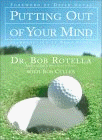Putting Out of Your Mind
The two Bobs are at it again.
Dr. Bob Rotella and his trusty scribe, Bob Cullen, recently finished another helpful book for golfers who are committed to seeking improvement in their game.
This one’s about putting, as the title makes fairly obvious. It also fits in well with the concepts Rotella/Cullen explored in Golf Is Not a Game of Perfect, Golf is a Game of Confidence, and The Golf of Your Dreams.
As befits a sports psychologist, Rotella stresses the mental aspects of the game. Of course, there’s far more of the mental in putting than the physical. Most golfers can’t match the PGA Tour pros drive for drive, but many amateurs can give the pros a run for their money on the putting green.
On the other hand, the fact that putting doesn’t make physical demands seems to make its mental demands that much harder. Actually, putting will only have that effect if you let it, and you don’t have to, as this slender volume explains.
Besides, improving putting skills will quickly lower most players’ handicaps. Rotella points out that golfers should love putting as much if not more than any other aspect of the game, if only because it makes up about 40 per cent of the strokes in a typical round.
As part of the learning process, for example, Rotella and Cullen note how the correct mental approach will help reduce or eliminate the body’s tiny twitches and spasms that can ruin a round. They amply prove that the subconscious can make minute adjustments that simply can’t be made through conscious effort. That’s why they stress concentrating on a target, and essentially “letting go” with the putting stroke, instead of locking in on the putter’s swing path,.
This book’s not just about mental gymnastics, however. Rotella and Cullen also provide some helpful playing and practice tips. I recommend Dottie Pepper’s practice regimen, at least the part they describe. It requires making three consecutive putts from 3, 5, and 7 feet. Miss any putt, and you must start over.
They’re certainly correct that the pressure to make the ninth consecutive putt will be noticeable. I also couldn’t help notice that successfully completing this practice before each round increases my confidence when I’m out on the course.
As with their other books, the two writers eventually stress that significant improvement requires a dedication to practice that low handicappers bring to their entire game. If average golfers spent half the time they now spend on the range on the putting green instead, doing the kinds of things Rotella describes, their handicaps should drop fairly quickly.
Brad Faxon wrote a good introduction, and David Duval’s foreword gives some insights into his final seven-foot putt for a record-setting 59 in the 1999 Bob Hope Chrysler Classic. Suffice it to say that these two professionals vouch for the guidance they’ve received from Bob Rotella. Pretty effective endorsements, it seems to me.
The book finishes with a handy summary of its main points, like the other books in the series, but don’t assume that just reading these tips will help you sink your next 15-footer. Read the book and practice what they preach, however, and you’ll definitely have a better chance at making your next crucial putt.
Review Date: July 15, 2001


